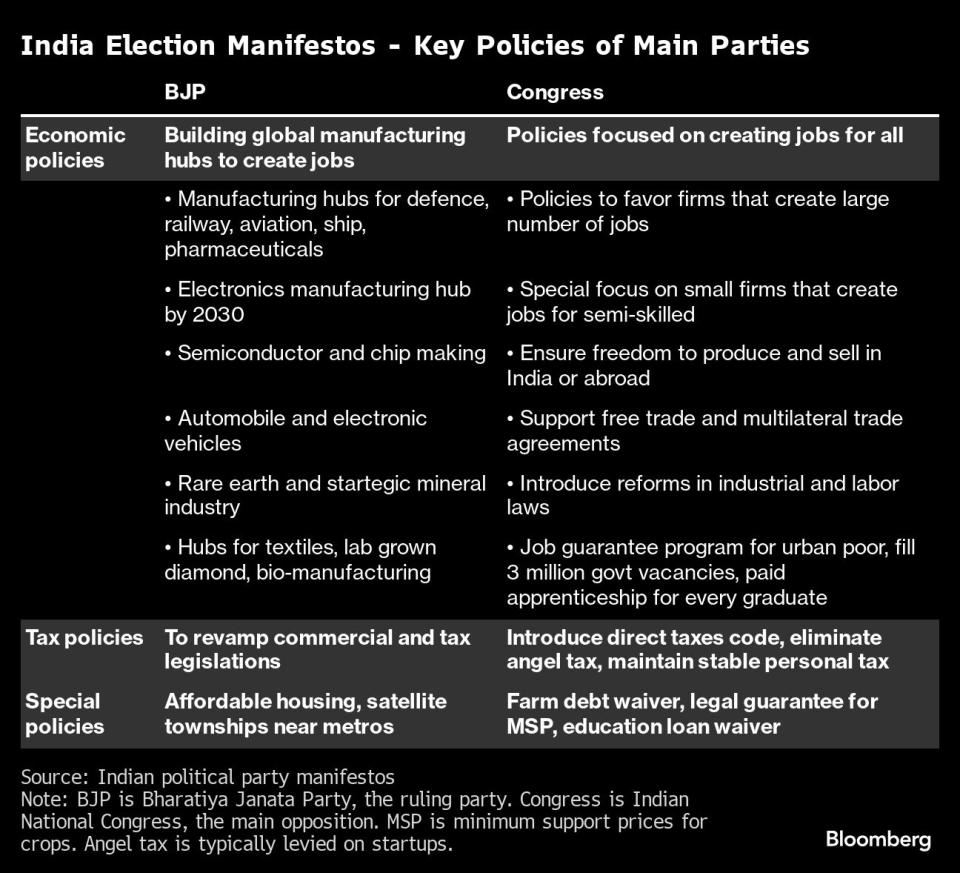Modi Is Center of Party Manifesto Focusing on Policy Stability
- Oops!Something went wrong.Please try again later.
(Bloomberg) -- Sign up for theIndia Edition newsletter by Menaka Doshi – an insider's guide to the emerging economic powerhouse, and the billionaires and businesses behind its rise, delivered weekly.
Most Read from Bloomberg
Beyond the Ivies: Surprise Winners in the List of Colleges With the Highest ROI
Iran’s Attack on Israel Sparks Race to Avert a Full-Blown War
Tesla Executive Baglino Leaves as Musk Loses Another Top Deputy
India’s ruling party put Prime Minister Narendra Modi at the center of its election manifesto, highlighting his record in fulfilling promises as it pledged to boost the economy.
The Bharatiya Janata Party’s manifesto — titled Modi ki Guarantee, or Modi’s guarantee — focused on creating jobs, boosting infrastructure and expanding welfare programs. The 76-page document referenced Modi’s name 65 times, and had 53 photos of his image.
“What stands out compared to previous manifestos is how everything is organized around the persona of the PM,” Gilles Verniers, a senior fellow at the Delhi-based Centre for Policy Research, told Bloomberg TV’s Haslinda Amin on Monday. “The BJP is not even talking about the government’s promises or the party’s promises but they are Modi’s promises.”
The prime minister remains hugely popular with voters and his party has relied on him as its main drawcard in elections since he swept to power in 2014. Modi is seeking a third term in office in voting that kicks off on Friday.
Economists said the BJP’s vows to create jobs, boost infrastructure and expand welfare programs if it wins a third term spells policy continuity in the world’s fifth-largest economy. Some also noted that while the party promised to lift incomes for the poor, the party didn’t outline any populous measures that would raise fiscal concerns.
“The manifesto is more tilted towards continuity than changes as the party might be confident on its last 10 years performance track record,” Citigroup Inc. economists Samiran Chakraborty and Baqar Murtaza Zaidi, wrote in a note.
However, the economists said there was an “absence of contentious structural reforms like land, labor, agriculture, privatization,” which could be a matter of concern.
The BJP’s election prospects have been buoyed by strong economic growth, welfare handouts and the fulfillment of populist, Hindu-nationalist promises, such as the inauguration this year of a contentious Hindu temple.
In the latest manifesto, Modi pledged to continue spending on infrastructure to turn India into a global manufacturing hub, and promised to enhance existing programs providing cash subsidies to farmers and free electricity.
Modi has been promising to turn India into a $5 trillion economy by 2027, from the current $3.5 trillion. He also aims to put India on track to become a developed country by 2047, its centennial year of independence. However, despite the country’s strong economic growth, unemployment and rising prices continue to be a worry among voters.
Verniers said that while the BJP’s manifesto highlighted economic inclusion as one of its objectives, it didn’t address high unemployment and unequal growth in the past decade.
“They are not exactly addressing the core issues, which is 10 years of relatively jobless growth where 10 years of concentration of capital in India, India’s economy has been rising,” he said. “It is one of the fastest growing economies in the world but the fruits, the benefits of that growth are immensely concentrated and these are issues that are not addressed in the manifesto.”
Rahul Gandhi, a top leader in the Indian National Congress, the country’s main opposition party, also highlighted the BJP’s failure to address the unemployment problem.
“Two words are missing from BJP’s manifesto and Narendra Modi’s speech - inflation and unemployment,” Gandhi wrote in a post on social media platform X. “BJP does not even want to discuss the most important issues related to people’s lives.”
The national elections will be held in seven stages, until June 1. The results will be released on June 4.
--With assistance from Anup Roy.
Most Read from Bloomberg Businessweek
A Resilient Global Economy Masks Growing Debt and Inequality
Top Takeaways From Businessweek’s Investigation of Teenage Sextortion
Race for AI Supremacy in Middle East Is Measured in Data Centers
©2024 Bloomberg L.P.



